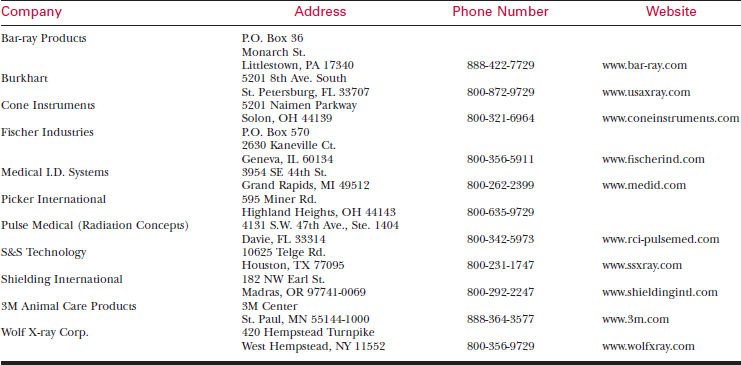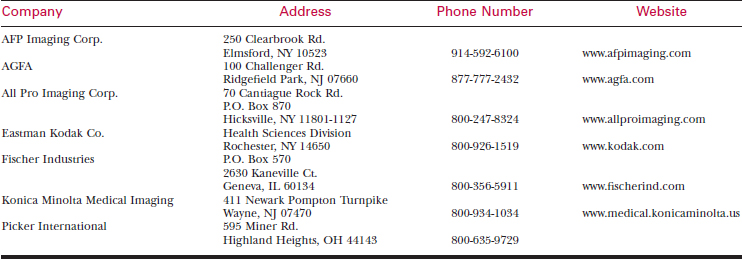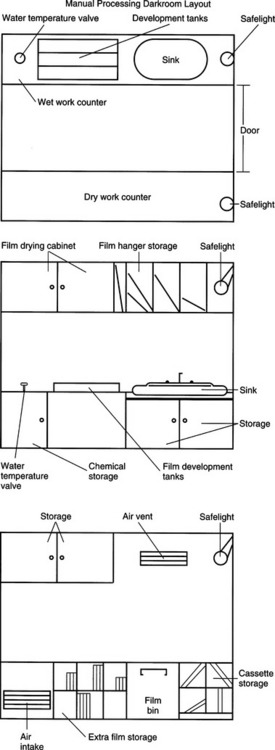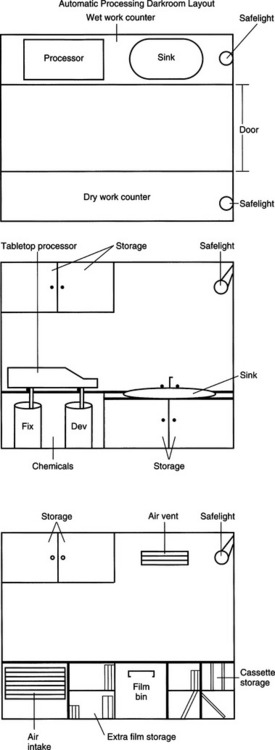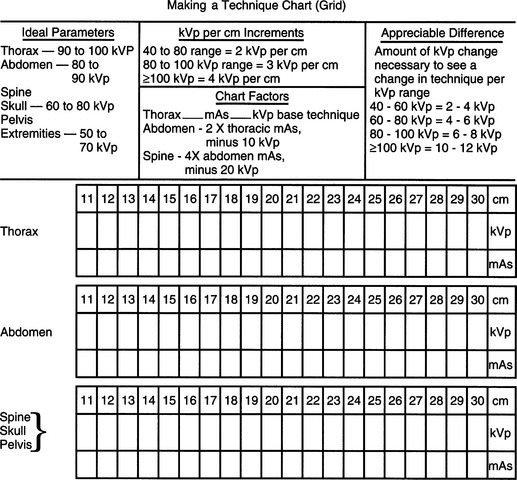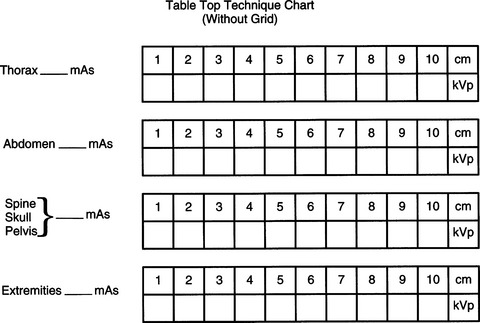Chapter 4 Radiographic and Ultrasonographic Techniques
The purpose of the radiograph is to provide a lasting record of maximum information. The sequence of the major operations involved in transforming the altered morphology and tissue density within a diseased animal into a two-dimensional, black-and-white radiograph and then reaching a diagnosis is complex and includes the following steps: (1) making a properly exposed and positioned radiograph; (2) recording the x-ray picture with the assistance of accessory equipment; (3) reviewing radiographs in proper conditions and in a systematic and detailed manner; (4) recognizing lesions—therefore [requiring] a knowledge of normal radiographic anatomy and its variation by age, species, and breed and the ability to recognize and understand artifacts; and (5) evaluating radiographic abnormalities with respect to clinical and laboratory findings.
X-RAY MACHINE
Milliampere-Second and Kilovolt Peak
Recommendations
ACCESSORY RADIOGRAPHIC EQUIPMENT
Intensifying Screens
Film
Cassettes
Miscellaneous Accessories
Table 4-6 RADIOGRAPHIC CONTRAST AGENTS
| Type of Contrast Agent | Brand Names | Manufacturers |
|---|---|---|
| Barium products | Intropaste (barium paste) | Lafayette Pharmacal (Lafayette, IN) |
| Barosperse (barium suspension) | Mallinckrodt (St. Louis, MO) | |
| Novopaque (barium suspension) | Lafayette Pharmacal (Lafayette, IN) | |
| E-Z-ML- 196 (barium suspension) | E-Z-EM (Westbury, NY) | |
| Iodinated gastrointestinal contrast agent | Gastrografin | Bracco Diagnostics (New Brunswick, NJ) |
| Omnipaque (iohexol) | Amersham Health (Piscataway, NJ) | |
| Iodinated contrast agent | Renografin 60 or 76 | Bracco Diagnostics (New Brunswick, NJ) |
| Hypaque-76 | Amersham Health (Piscataway, NJ) | |
| Conray 30 or 400 | Mallinckrodt (St. Louis, MO) | |
| Myelographic contrast agent | Omnipaque (iohexol) | Amersham Health (Piscataway, NJ) |
| Isovue (iopamidol) | Bracco Diagnostics (New Brunswick, NJ) |
CHECKING X-RAY MACHINE ACCURACY
Milliampere Station Check
Compare the densities of all exposures. They should be the same for all mA stations taken at the same mAs. An exposure that varies from the average shows that there is a problem with that mA station. This test does not tell you if all mA stations are accurate, but it does tell you if a particular station has a problem.
Kilovolt Peak Check
The only accurate way to check the kVp is the Wisconsin test cassette ($1300; see Table 4-3 for sources).
| 100 mAs at 50 kVp | 3.1 mAs at 81 kVp |
| 50 mAs at 55 kVp | 1.5 mAs at 90 kVp |
| 25 mAs at 61 kVp | 0.8 mAs at 99 kVp |
| 12.5 mAs at 67 kVp | 0.4 mAs at 108 kVp |
| 6.2 mAs at 74 kVp | 0.2 mAs at 124 kVp |
Exposure Timer Check (Single-Phase Machine)
Use a spinning-top test tool. It can be purchased from the same company as the machine (see Table 4-1) or from an accessory company (see Table 4-3). This tool is inexpensive ($50) and easy to use. It is a flat metal spinning top with a hole in one side. The top is set on a loaded cassette and spun. Take an exposure at 1/120 second. Move the top to another corner of the film, spin again, and expose at 1/60 second. This maneuver is repeated at 1/40 and 1/30 second. At 1/120 second, only one dot should be seen; at 1/60, two dots; at 1/40, three dots; and at 1/30, four dots. If more or less dots are on the film than expected, the timer is not accurate.
Line Voltage
Line voltage is the amount of current coming into the machine. The amount of current may vary, depending on electrical wiring, consistency of voltage in the area, and usage of current on the same circuit in the particular practice. Almost all machines used for small animals have a line voltage-check device. Some have a meter and a dial to adjust line voltage and do not permit exposure until the voltage is manually adjusted. Other machines have an automatic line voltage adjustment. Almost all equipment in small animal practice uses 120 volts (i.e., right out of the socket).
FILM PROCESSING
Manual Processing
Film developing is a chemical process and therefore depends on both time and temperature.
Radiograph Labeling
Procedure for Manual Film Processing
Automatic Processing
Darkroom
Recommendations
TECHNIQUE CHARTS
Technique Chart (with Grid) (Fig. 4-3)
Thorax with Grid
Technique Chart (Tabletop without Grid) (Fig. 4-4)
Thorax, Abdomen, and Spine
Extremity
POSITIONING AND TECHNIQUE
Measuring for Radiographic Studies
Stay updated, free articles. Join our Telegram channel

Full access? Get Clinical Tree




